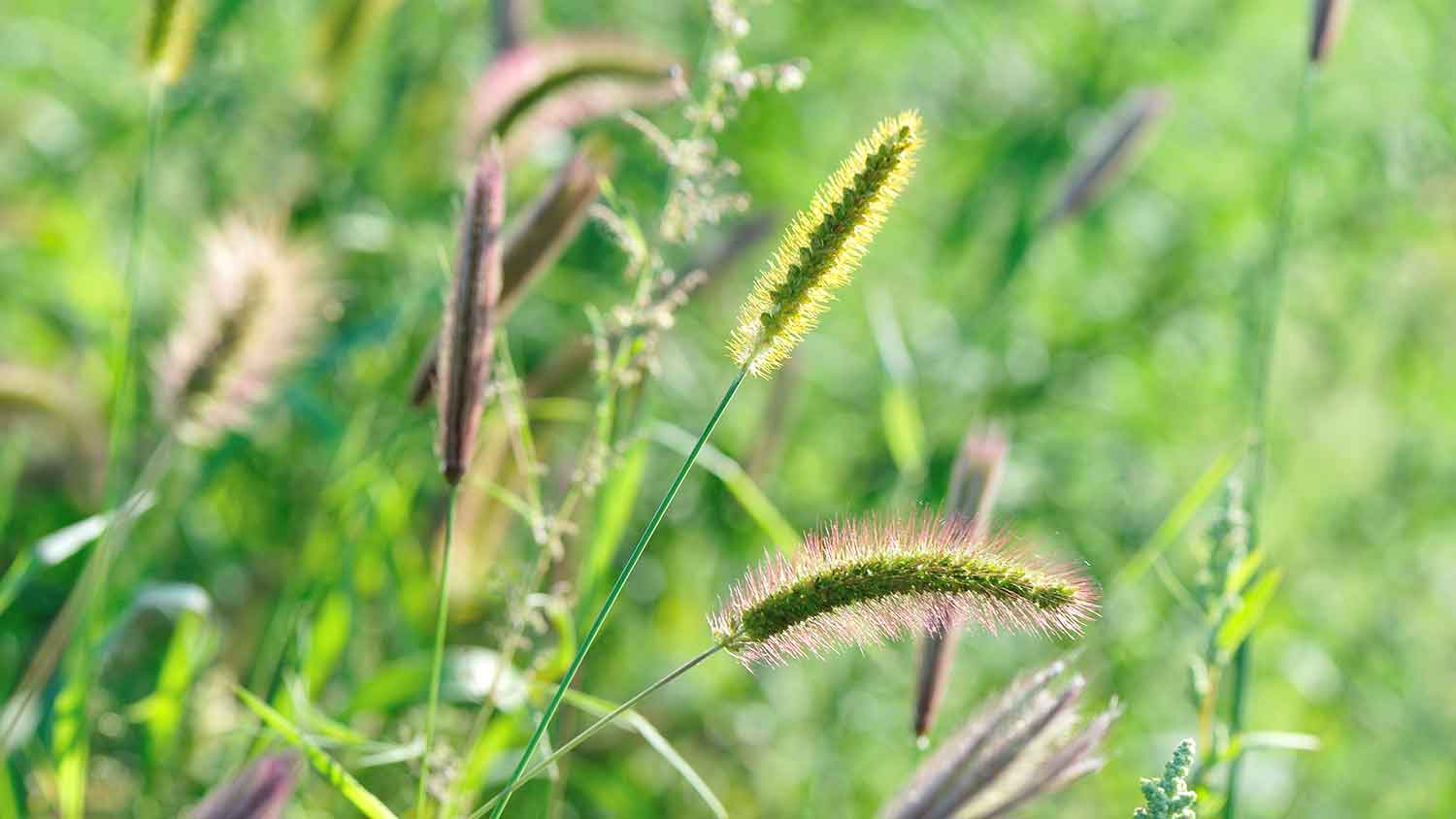What Is Foxtail Grass? A Complete Guide
Don’t let this soft, grassy weed fool you


Foxtail grass can thrive in moist and dry climates.
This grass variety is self-seeding and spreads easily.
Foxtail grass is dangerous to livestock and pets.
Foxtail grass isn't picky about its growing locations and conditions. This common grassy weed grows in ditches, roadsides, pastures, gardens, and lawns. Although it has an adorable name, don't let this fuzzy grass fool you. It may look harmless, but this grass type is dangerous to pets and livestock. If you spot foxtail grass in your yard, don’t hesitate to hire a professional lawn care service to remove it. Let’s dive into the characteristics of foxtail grass, what it looks like, and the potential health risks it causes to your pets and other animals.
What Is Foxtail Grass?

Foxtail is a summer grassy weed in the Poaceae family and is the genus of Setaria and Alopecurus. Its name comes from its fluffy head resembling a bushy fox tail. The fuzzy head of this type of grass contains bristly seeds that allow it to self-seed among other grasses.
This grass variety grows in clumps, although they can grow individually and thrive in dry or moist soil. Foxtail grass can be annual or perennial, depending on its species. However, summer annual grasses are the most common types in the United States. Foxtail grass begins germinating in spring and continues through mid-summer.
Common Types of Foxtail Grass
Although there are many types of foxtail, there are three common types to watch out for. While they share the same fuzzy characteristics, they have distinguishable differences that make them easier to identify.
Green Foxtail
Green foxtail can grow between one and three feet tall and it’s an annual summer grassy weed. The leaves are flat, can grow up to 12 inches long, and typically do not have “hair.” The seed heads are also a cylindrical shape with soft bristles, and the color can be green or purple-tinted. The seed heads are between one to four inches long and are normally upright with a slight nod.
Yellow Foxtail
Yellow foxtails can grow one to four feet tall at maturity, and they tend to pop up in disturbed areas. The leaves are smooth and flat and can grow between two to 12 inches long. The bristly cylindrical seed head is smaller than its counterparts, and the awns turn yellow at maturity.
Giant Foxtail
Giant foxtail can stand up to 6½ feet tall but typically will grow to about four feet. Seed heads are also cylindrical but larger than the other types of foxtail. This variety can grow between two to seven inches long, featuring a green color.
Even the leaves are giant on this type of foxtail, reaching lengths of up to 16 inches long. The seed head of a giant foxtail will droop at maturity, which helps to identify it.
Foxtail vs. Timothy Grass
Timothy grass is for pastures and used for its high nutritional value in forage crops. It is a cool-season perennial grass that lays dormant during the winter and grows yearly. Since Timothy grass has a fluffy seed head, people confuse it with foxtails. However, upon further inspection, you will notice that Timothy grass has a few traits that can help identify it from its hazardous counterpart.
For instance, Timothy's grass will always be upright. If you examine the collar region, you will see that foxtails have fringe hairs, but Timothy grass has a tall membrane. Both grasses have a warm and fuzzy appearance, but with foxtail, there is more than meets the eye.
Dangers of Foxtail Grass

Foxtail has sharply barbed seeds that can cause injury, infection, and even death in livestock and pets. The awns can lodge in the animal's skin, throat, nose, and ears. It can migrate throughout various parts of the body, with the risk of entering the brain or perforating the lungs.
If you suspect or find foxtail awns on your pet, you should visit a veterinarian to ensure they are removed correctly. That is why it’s vital to remove foxtail grass from your lawn, especially if you have outdoor pets.
Should I Hire a Professional to Remove Foxtail Grass?
Foxtail grass can produce hundreds to thousands of seeds per plant, and seeds can remain viable for several years in some instances. Due to its health risk to pets, we recommend hiring a professional lawn care service to ensure you get rid of it for good. These lawn care pros can recommend the best, most efficient plan of action for removing the hazardous grass from your yard.
The cost of removing foxtail will vary depending on your yard's size and the recommended treatment plan. However, it costs between $60 to $180 per ¼ acre for a professional to spray herbicides. Contact a lawn care service near you to get accurate estimates based on your lawn size and amount of foxtail present.
Frequently Asked Questions
Foxtail self-seeds and dispurses them among other grasses and pastures. The seeds can spread by wind and by attaching themselves to animals and humans. Seeds will germinate in their new location and become a new plant, which continues the spread of foxtail. Unfortunately, foxtail spreads easily, making it difficult to remove unless it’s caught quickly.
Foxtail grass is not native to the United States, so it is considered an invasive plant. Giant foxtail originated in eastern Asia, Green foxtail is native to Europe, and Yellow foxtail is native to Eurasia. This grass variety is one of many common invasive plant species that you should keep out of your yard and garden beds as much as possible.





- When the Grass Is Greener: 10 Best Grass Types for Your Lawn
- What Is Bermuda Grass? Everything You Need to Know for a Healthy, Green Lawn
- 9 Showstopping Types of Ornamental Grass to Liven Your Landscape
- When Grass Becomes a Weed: How to Control and Get Rid of Bermuda Grass
- 6 Ways to Kill Grass On Your Lawn
- How to Kill Orchard Grass in Your Lawn and Control It for Good
- What Do You Put Down First: Grass Seed Or Fertilizer?
- Pros and Cons of No-Mow Grass: What to Consider
- Bahia vs. Bermuda Grass: What’s the Difference?
- 7 Tips for Keeping Your Grass Green During a Drought










